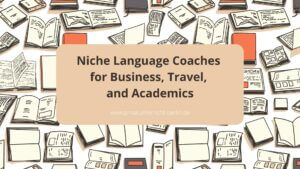Your Language Journey, Your Way: Start with a Private Tutor

Focusing And Minimizing Distractions In Web-Based Language Lessons
Welcome to this lesson on focusing and minimizing distractions in web-based language lessons!
As an expert in online education, I understand the challenges of staying focused while studying languages in a digital environment. With so many websites and apps competing for our attention, it’s easy to get sidetracked and lose sight of your learning goals.
But fear not! This article will explore practical strategies for maximizing productivity during online language lessons. Whether taking classes with a teacher or using self-study materials, these tips will help you stay engaged and motivated throughout your studies.
So let’s dive in and discover how you can make the most of your online language learning experience!
Table of Contents
Setting Up Your Study Environment
Imagine entering a room with all kinds of distractions – the TV blaring, people talking loudly, and phones ringing. How would you feel? Unsettled? Overwhelmed?
It’s hard to focus in such an environment.
The same goes for studying online. With so many distractions on your computer screen and around you, it can be challenging to concentrate on language lessons.
That’s why setting up your study environment should be one of the first things you do before embarking on any web-based learning journey.
Let’s explore some study space essentials and tips for eliminating background noise to help you get started!
Developing A Study Routine
Now that we’ve discussed the importance of focusing during your web-based language lessons let’s discuss developing a study routine.
Consistency in your study routine will help you stay on track and make it easier to maintain focus throughout each lesson.
Start by setting aside a specific time and place for your daily language studies. This can be as simple as dedicating an hour after dinner or finding a quiet coffee shop to work in.
Once you have established this habit, try incorporating breaks into your routine. Taking short breaks every 20-30 minutes can increase productivity by giving your brain a chance to recharge. Use these breaks to stretch, grab some water, or step away from the computer screen for a few moments before returning to the task.
As important as establishing consistent habits is minimizing digital distractions while studying online. Let’s explore some strategies for doing so in our next section.
Minimizing Digital Distractions
As we delve deeper into minimizing digital distractions, it is crucial to understand that distractions take away from your language learning experience and hinder your progress.
This is where mindfulness techniques and blocking software come in handy.
Mindfulness techniques involve being present at the moment while engaging with the language lesson. It means avoiding multitasking and focusing on one task at a time.
On the other hand, blocking software helps you eliminate potential distractions by limiting access to certain websites or apps during designated study periods.
Incorporating both tools into your language learning routine allows you to create an environment that fosters concentration and enhances your learning experience.
Engaging With Interactive Learning Resources
Visual aids can be a powerful tool to help learners stay focused and motivated when learning a language online.
Using multimedia content like videos and animation can keep students engaged and reduce distractions.
Adaptive learning techniques can also be beneficial, allowing students to progress at their own pace while enjoying a personalized learning experience.
Visual Aids
As we delve deeper into engaging with interactive learning resources, it is crucial to consider the role of visual aids.
Visual aids can be a powerful tool for language learners as they enhance comprehension and provide an immersive experience during web-based lessons.
Interactive exercises such as games or quizzes incorporating multimedia presentations like images or videos are effective ways to keep learners engaged while minimizing distractions.
By appealing to different senses and incorporating various forms of media, visual aids facilitate better retention and recall of information.
As experts in focusing and minimizing distractions, we must use these tools strategically and sparingly to keep our students manageable.
Multimedia Content
Now that we have established the importance of visual aids in engaging with interactive learning resources let’s look at another multimedia content: audiovisual materials.
Including videos and audio recordings as part of your web-based lessons can add an extra dimension to the learning experience. Interactive exercises incorporating these materials allow learners to practice listening comprehension skills while reinforcing vocabulary and grammar concepts.
However, it is vital to use audiovisuals strategically and avoid overwhelming students with too much information or distracting visuals. As experts in minimizing distractions, we must balance using multimedia content effectively and ensuring that it enhances rather than detracts from the overall learning experience.
Adaptive Learning Techniques
Now that we have explored the use of audiovisual materials in engaging with interactive learning resources let’s delve into another important topic: adaptive learning techniques.
As language instructors, it is crucial to provide learners with a personalized curriculum that caters to their individual needs and strengths. An effective way to do this is by utilizing data-driven feedback mechanisms that help identify areas for improvement and adjust teaching strategies accordingly.
Incorporating adaptive learning techniques enhances engagement and ensures students progress at their own pace without getting overwhelmed or bored.
So how can we implement these techniques? Let’s find out together!
Staying Motivated And Accountable
Now that we have explored engaging with interactive learning resources let’s talk about the importance of staying motivated and accountable in your language-learning journey. It can be easy to lose focus or become distracted when studying online, but there are some strategies you can use to maintain your motivation and stay on track.
One important strategy is goal setting. By setting clear goals for yourself, such as mastering a specific grammar concept or being able to hold a conversation in your target language, you give yourself something concrete to work towards. Make sure your goals are realistic and achievable within a reasonable timeframe.
You can also break larger goals into smaller milestones to celebrate your progress along the way. Additionally, having peer support can help keep you accountable and motivated. Consider joining an online language-learning community where you can connect with others with similar goals and interests.
This support system can provide encouragement and accountability when you need it most.
Frequently Asked Questions
What Common Types Of Digital Distractions Language Learners May Encounter During Web-Based Lessons?
Digital distractions are rampant and can quickly derail the learning process for language learners during web-based lessons. As a focus and distraction minimization expert, I have to investigate the truth of this theory to emphasize its importance.
One must balance focus and engagement in their studies to truly engage with the lesson material. Language learners may encounter common digital distractions, including social media notifications, email alerts, pop-up ads, and even other open tabs or windows on their computer screen.
Solutions to these distractions can range from turning off notifications, closing unnecessary browsers or apps, setting designated study time without interruptions, or using website blockers to limit access to distracting sites. The key is realizing when a distraction occurs and having strategies to combat them not to hinder progress in language learning.
How Can Learners Determine The Most Effective Study Routine For Their Learning Style?
To truly optimize your language learning journey, it’s essential to determine the study routine that best suits your learning style.
Learning style assessment tools can be incredibly helpful in identifying what type of learner you are – visual, auditory, or kinesthetic – and tailoring your approach accordingly.
Additionally, good time management techniques are integral to ensuring that you stay focused during web-based lessons and minimize distractions.
Don’t be afraid to experiment with different strategies until you find the ones that work best for you!
Are Any Specific Strategies For Engaging With Interactive Learning Resources Particularly Effective For Language Learners?
Language learners can benefit from peer support and gamification techniques regarding interactive learning resources.
Peer support allows learners to interact with others studying the same language, providing opportunities for practice and feedback.
Gamification techniques, such as point systems or leaderboards, make learning more engaging by turning it into a game-like experience.
By incorporating these strategies into their study routine, language learners can increase motivation and improve their performance.
As an expert in web-based language lesson focus and distraction minimization, I highly recommend these approaches to anyone looking to enhance their language learning experience.
What Should Learners Do If They Find Themselves Struggling To Stay Motivated During Web-Based Language Lessons?
If you’re struggling to stay motivated during your web-based language lessons, don’t worry! Many motivational techniques can help keep you engaged and focused.
First, try finding an accountability partner to hold you responsible for completing your lessons on time.
Secondly, practice mindfulness by taking breaks throughout the lesson to clear your mind and refocus.
Lastly, effective time management is crucial in staying motivated during online learning; avoid distractions by setting specific times for studying and sticking to them.
Remember, with a little effort and determination; anyone can master a new language through web-based lessons!
Are Any Recommended Tools Or Technologies That Can Help Learners Minimize Distractions During Their Study Sessions?
Various recommended tools and technologies are available to help learners minimize distractions during their study sessions.
Gamification techniques can make language learning more engaging and enjoyable for students. By incorporating game-like elements such as points, badges, and leaderboards into the learning process, learners are incentivized to stay focused and motivated throughout their lessons.
Additionally, mindfulness practices can also aid in minimizing distractions by promoting a clear and calm state of mind. Techniques such as breathing exercises and meditation can be incorporated into the lesson plan to increase concentration and reduce stress levels.
Utilizing these tools and techniques can significantly enhance the effectiveness of web-based language lessons while minimizing potential distractions.
Conclusion
So there you have it, language learners! You now know the common digital distractions that can hinder your web-based lessons and how to determine the most effective study routine for your learning style.
But what about engaging with interactive resources? Fear not, for there are specific strategies that can help you make the most of these tools.
But wait, what if you still struggle to stay motivated during your web-based language lessons? Don’t worry – this is a common problem that many learners face.
Just remember to take breaks when needed, set achievable goals for each session, and always remember why you started learning the language in the first place. And if all else fails, try incorporating some recommended tools or technologies into your study sessions to minimize distractions and increase productivity.
Happy learning!



